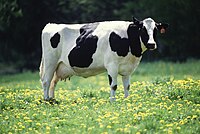
Photo from wikipedia
Treatment of clinical mastitis (CM) and use of antimicrobials for dry cow therapy are responsible for the majority of animal-defined daily doses of antimicrobial use (AMU) on dairy farms. However,… Click to show full abstract
Treatment of clinical mastitis (CM) and use of antimicrobials for dry cow therapy are responsible for the majority of animal-defined daily doses of antimicrobial use (AMU) on dairy farms. However, advancements made in the last decade have enabled excluding nonsevere CM cases from antimicrobial treatment that have a high probability of cure without antimicrobials (no bacterial causes or gram-negative, excluding Klebsiella spp.) and cases with a low bacteriological cure rate (chronic cases). These advancements include availability of rapid diagnostic tests and improved udder health management practices, which reduced the incidence and infection pressure of contagious CM pathogens. This review informed an evidence-based protocol for selective CM treatment decisions based on a combination of rapid diagnostic test results, review of somatic cell count and CM records, and elucidated consequences in terms of udder health, AMU, and farm economics. Relatively fast identification of the causative agent is the most important factor in selective CM treatment protocols. Many reported studies did not indicate detrimental udder health consequences (e.g., reduced clinical or bacteriological cures, increased somatic cell count, increased culling rate, or increased recurrence of CM later in lactation) after initiating selective CM treatment protocols using on-farm testing. The magnitude of AMU reduction following a selective CM treatment protocol implementation depended on the causal pathogen distribution and protocol characteristics. Uptake of selective treatment of nonsevere CM cases differs across regions and is dependent on management systems and adoption of udder health programs. No economic losses or animal welfare issues are expected when adopting a selective versus blanket CM treatment protocol. Therefore, selective CM treatment of nonsevere cases can be a practical tool to aid AMU reduction on dairy farms.
Journal Title: Journal of dairy science
Year Published: 2023
Link to full text (if available)
Share on Social Media: Sign Up to like & get
recommendations!